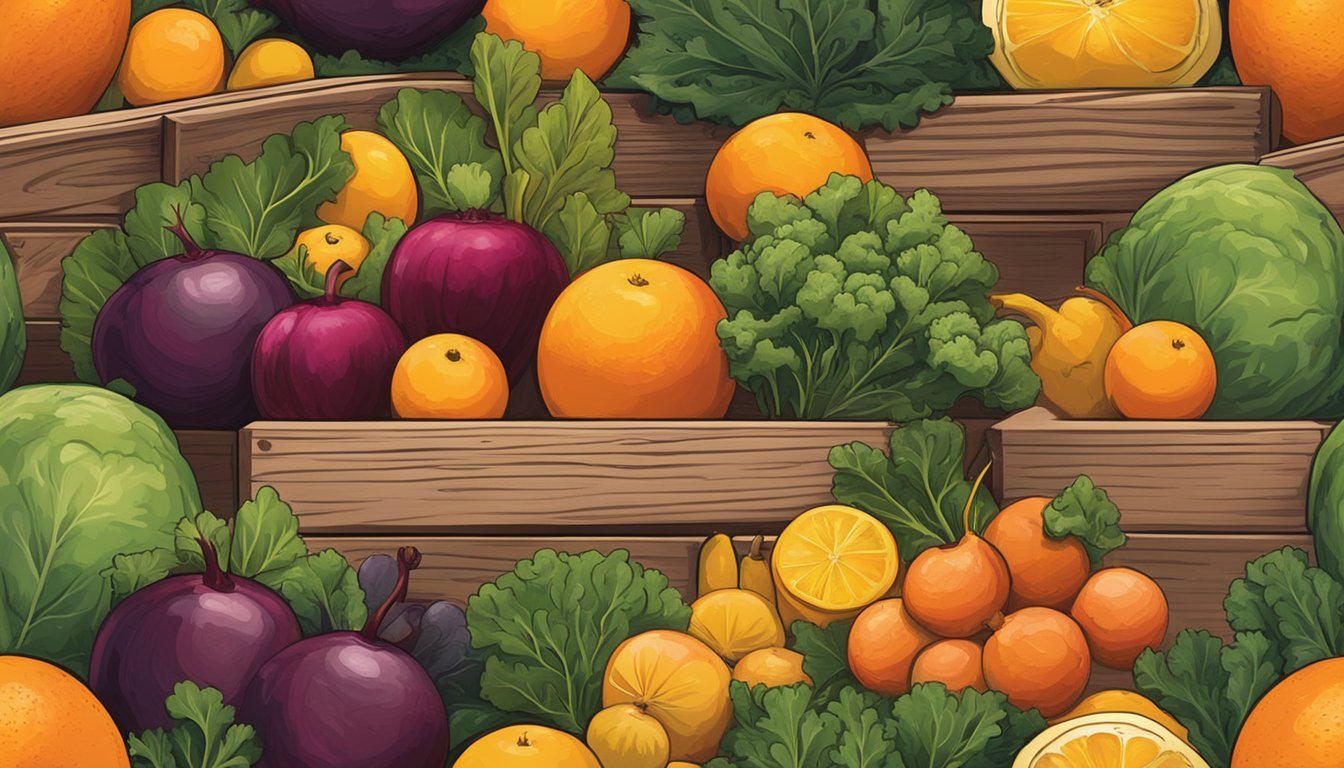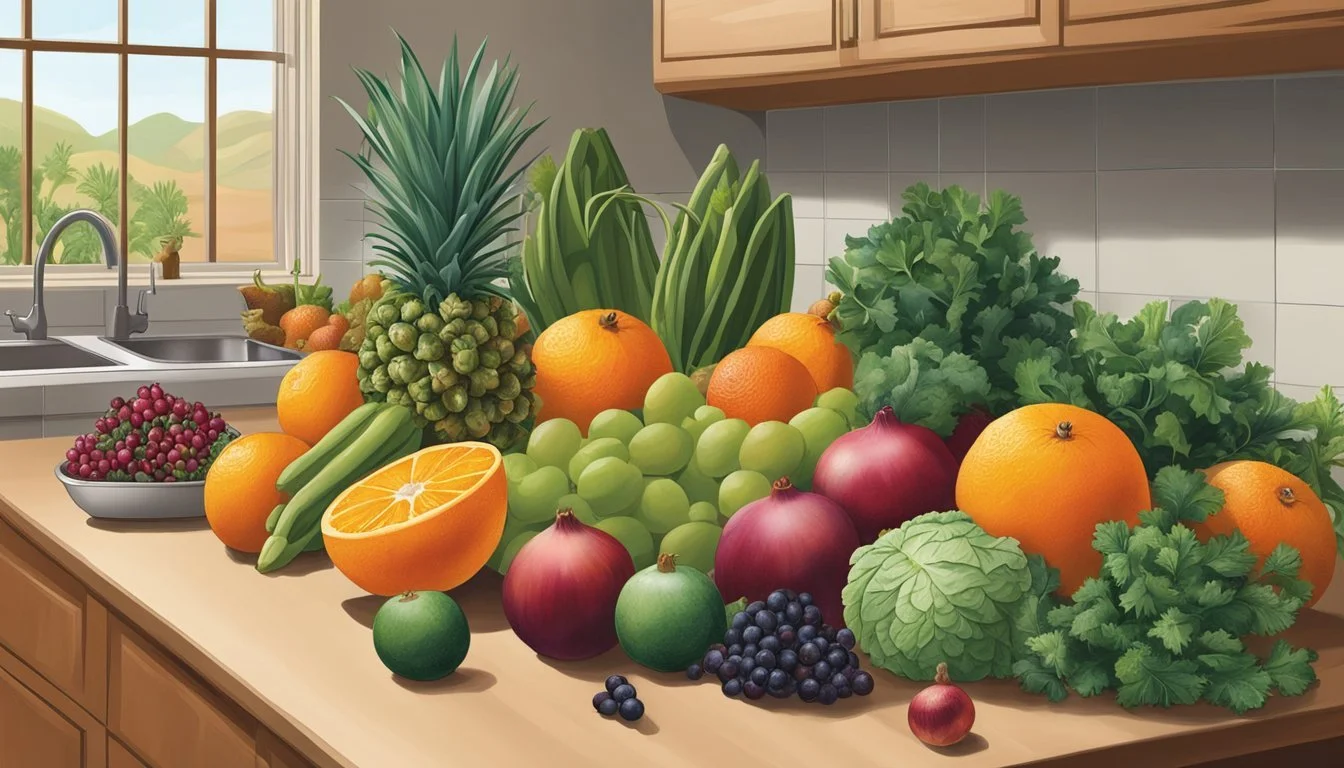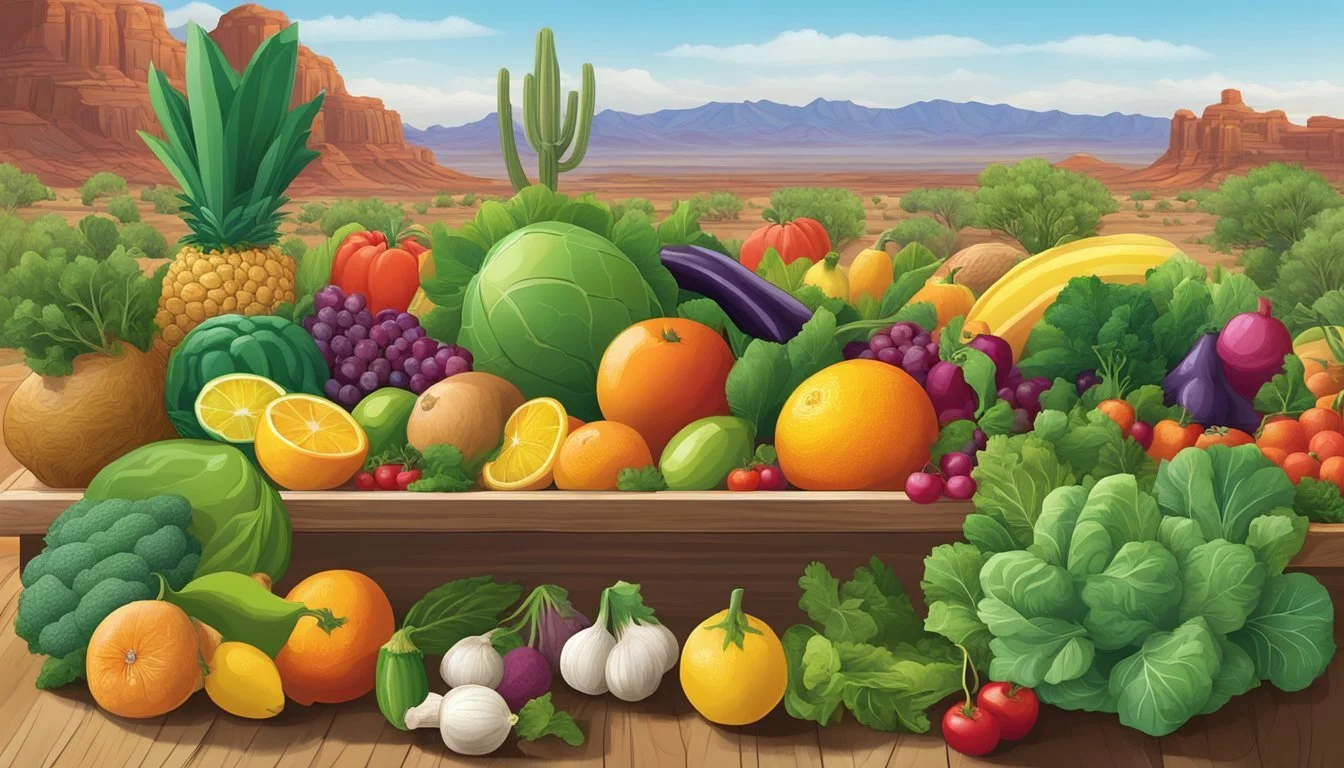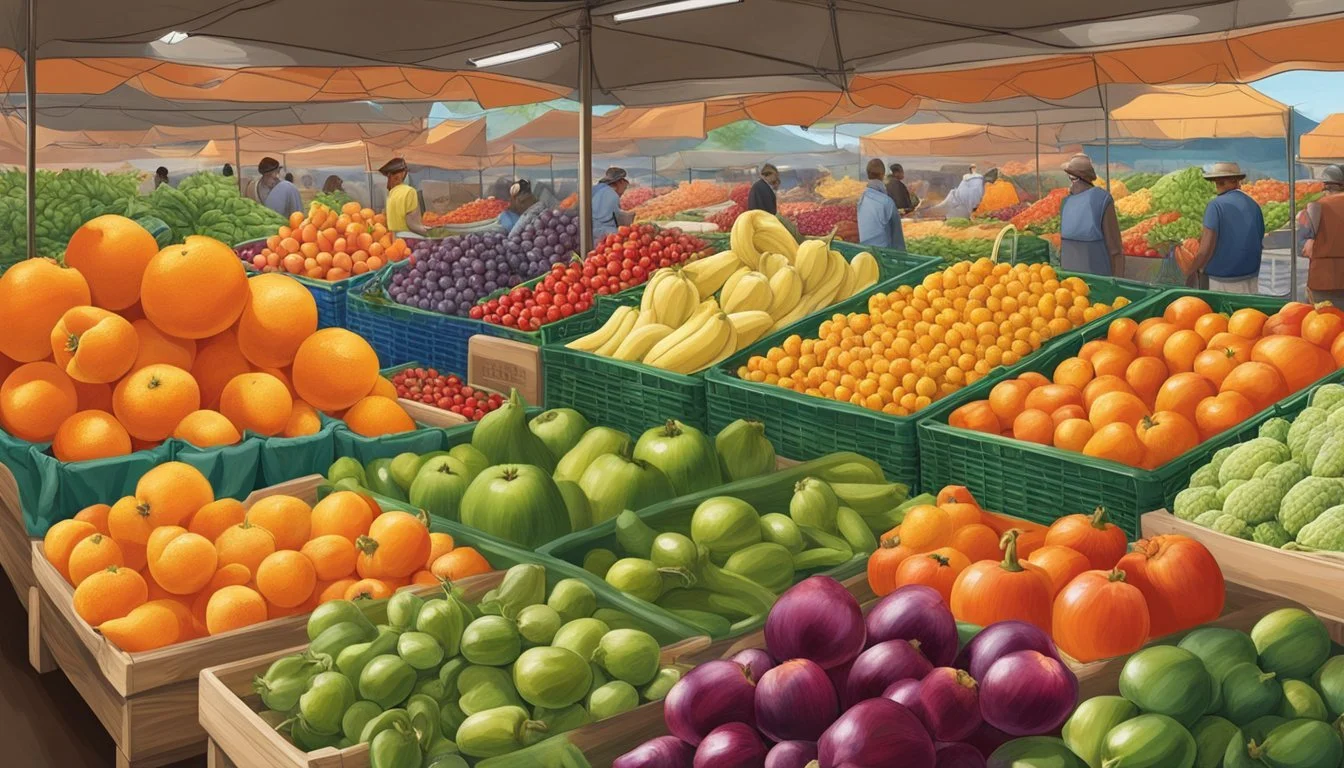Arizona Seasonal Fruit & Vegetables in December
Your Guide to Fresh Produce
This Article is Part of our Arizona Seasonal Fruit & Veg Calendar
In Arizona, the month of December marks a transition in the agricultural calendar as the state welcomes the bounty of winter harvests. Amidst the cooler temperatures, a variety of produce reaches its peak, providing an abundance of fresh and flavorful fruits and vegetables unique to the season. The state's diverse climate zones contribute to a rich selection that includes cool-weather crops alongside those that thrive in milder conditions.
Seasonal fruits such as crisp apples, including varieties like Ambrosia, Fuji, Gala, and Golden Delicious, remain available from local orchards. The selection of vegetables also broadens during this month with the availability of hearty greens and root vegetables. Broccoli (how long does broccoli last?) raab and Brussels sprouts (how long do brussels sprouts last?) offer robust flavors and are versatile in winter recipes, while cabbage, carrots (how long do carrots last?), and celery root present opportunities for warm, comforting dishes.
As winter sets in, Arizona's agricultural scene does not wane but instead showcases a robust repertoire of produce. The seasonal availability ensures that consumers can enjoy fresh, locally-grown fruits and vegetables, reflecting Arizona's rich agrarian heritage and its commitment to food that is both seasonal and sustainable.
Understanding Arizona's Produce Seasons
Arizona's climate and seasons significantly affect the types of produce available throughout the year. Winter months, spanning November to February, bring a unique set of vegetables and fruits that thrive in the cooler conditions.
Winter Produce Overview
In the winter, Arizona's harvest includes a variety of vegetables and leafy greens suited to the cooler temperatures. Residents can find a wide array of fresh produce that is both delicious and nutritious.
Vegetables:
Broccoli raab (December through March)
Brussels sprouts (December through March)
Cabbage (January through April)
Carrots (October through May)
Celeriac/celery root (January through April)
Celery (January through April)
Citrus Fruits:
Oranges (usually ripe in December)
Grapefruits (peak season starts in December)
Tangerines (through the winter season)
December's Unique Climate Influence
December in Arizona marks the transition to cooler temperatures, which impacts the growth and flavor of various crops. The state's agricultural diversity allows for a broad selection of fresh produce, highly influenced by regional microclimates.
Cooler Climate Effects:
Enhanced sweetness in citrus fruits due to cold nights.
Robust growth for certain vegetables that prefer lower temperatures.
Regional Variations:
Low desert regions see extended harvesting times.
Higher elevations have shorter growing seasons, affecting availability.
Winter's Bounty: Seasonal Vegetables in December
December in Arizona offers a rich harvest of robust root vegetables and crisp, nutritious leafy greens. These categories are central to the local seasonal cuisine and offer a variety of health benefits and culinary uses.
Root Vegetables and Tubers
Carrots: A staple root vegetable, carrots are known for their sweetness and versatility. In December, they reach peak season, boasting a high concentration of beta-carotene.
Beets: Available from November through May, beets (how long do beets last?) are at their best in December. They come in varieties ranging from the common red to golden and striped Chioggia, each with a unique flavor profile.
Turnips and Radishes: Often grouped together due to their similar shape and growing season, these root vegetables bring a peppery punch to dishes, with turnips offering a slightly milder flavor compared to the sharper zest of radishes.
Availability Table for Root Vegetables:
Vegetable Availability Carrots October - May Beets November - May Turnips October - March Radishes October - April
Cruciferous and Leafy Greens
Broccoli: This cruciferous vegetable thrives in cooler temperatures, which makes Arizona’s December climate ideal for yielding tender and flavorful florets.
Brussels Sprouts: Similar to broccoli, they are best when harvested after the first frost of the year, leading to improved sweetness and a nuttier flavor profile in December.
Cauliflower: Like its relatives, cauliflower benefits from the cooler weather and grows well during the Arizona winter months, perfect for a variety of dishes from roasted sides to creamy soups.
Cabbage and Kale: (What wine goes well with kale?) Both cabbage and kale are robust greens that flourish in the winter, offering dense nutrition and rich, earthy flavors (What wine goes well with earthy flavors?) that enhance warm meals.
Greens: Beyond kale, a variety of other greens are in season. These leafy vegetables are excellent for salads, sautés, and as nutrient-dense additions to smoothies and juices.
By focusing on seasonal produce, Arizona residents and visitors can enjoy the freshest vegetables available while supporting local agriculture and reducing the environmental impact associated with long-distance food transportation.
Seasonal Fruits to Enjoy
December in Arizona brings a bounty of seasonal fruits, particularly citrus, that one can savor at their peak freshness and taste.
Citrus Galore
In December, Arizona's citrus is exceptionally sweet and abundant. Home to a variety of citrus fruits, one can enjoy a selection including:
Oranges: A classic winter fruit, oranges are juicy and packed with Vitamin C.
Clementines: Smaller and sweeter, clementines are a seasonal favorite, often easy to peel and seedless, perfect for a quick snack.
The citrus season is not only marked by its variety but also by the high quality of produce available during this month.
Other Winter Delicacies
Apart from citrus, other fruits also grace the tables in Arizona during December:
Pears: With a buttery texture, pears are versatile for cooking or can be eaten raw.
Apples: Different varieties of apples such as Fuji, Gala, and Golden Delicious are harvested and can be enjoyed for their crispness and sweetness.
These fruits are not only enjoyed fresh but are also commonly used in seasonal recipes, making them an integral part of December's culinary experiences in Arizona.
Using December Produce in Your Kitchen
In Arizona, December blesses the kitchen with a variety of fresh, local produce that can be transformed into delectable holiday fare and comforting meals. The cooler season brings forth a bounty that is perfect for traditional recipes, and innovative dishes alike, from festive gatherings to warm, nourishing dinners.
Holiday-Inspired Recipes
During the holiday season, Arizonans can take advantage of local produce such as kale and Brussels sprouts to create festive dishes. Kale, a versatile green, can be used in side dishes or as a base for a holiday salad with pomegranate seeds (how long do pomegranate seeds last?) for a pop of color and flavor. Brussels sprouts, on the other hand, can be roasted with a drizzle of olive oil and a sprinkle of coarse salt to create a simple yet flavorful side that pairs well with any main course.
Roasted Vegetables:
Beets: Roast until tender, then season.
Carrots: Enhance their natural sweetness with a honey glaze.
Salads:
Add raw, sliced fennel (how long does fennel last?) to salads for a crunchy, slightly sweet addition.
Warm Soups and Hearty Salads
As the temperatures drop, chefs often turn to soups to warm up the kitchen. Vegetables like celeriac and carrots make for hearty soup bases and can be pureed for a smooth consistency or left chunky for a more rustic feel. They can be seasoned with herbs such as thyme and rosemary for added warmth and depth of flavor.
For those preferring salads, incorporating roasted vegetables (What wine goes well with roasted vegetables?) such as beets and sweet potatoes into a bed of greens provides a satisfying and hearty experience. They can be dressed with a simple vinaigrette to enhance their natural flavors and mixed with nuts or seeds for added texture.
Soups:
Celery root: Use as a base for a creamy soup.
Romanesco: Blend into soups for a vibrant color and nutty taste.
Hearty Salads:
Roasted beets: Combine with goat cheese and nuts for a filling salad.
Sweet potatoes: Roast and mix with quinoa for a substantial dish.
Where to Find Local Produce
In Arizona, December brings a variety of seasonal fruits and vegetables that are readily available. Shoppers can find fresh, locally-sourced produce at various outlets, each offering a glimpse of the state's agricultural diversity.
Farmers Markets and Supermarkets
Farmers Markets in Arizona are bustling hubs where local farmers bring their fresh harvest directly to consumers. These markets are a fantastic source for seasonal items such as Brussels sprouts and root vegetables like carrots. Shoppers looking for the freshest Arizona produce should check schedules for markets in their area, as they often operate weekly.
Phoenix Area Markets: Open year-round, providing consistent access to local produce.
Cooler Areas Markets: May have adjusted schedules but still offer an array of seasonal selections.
Supermarkets have also started to prioritize local produce, stocking Arizona-grown fruits and vegetables to support local farmers and meet consumer demand for freshness. Supermarkets are a convenient option, with most stores featuring sections dedicated to local produce.
Regional Differences: Phoenix and Cooler Areas
The Phoenix metropolitan area, known for its warmer climate, has a longer growing season. This means that a wide variety of local fruits and vegetables, such as leafy greens and root crops, are readily available in supermarkets and farmers markets. The abundance of sunshine allows for a robust selection of fresh produce throughout December.
Cooler Areas, including the highlands and northern regions, experience a shorter growing season. However, some hardy produce such as cabbages and root vegetables can still be sourced from these regions, offering a taste of Arizona's diverse climatic offerings. Farmers in these areas often grow varieties that can withstand the cooler temperatures, ensuring that even in December, markets and supermarkets can stock these locally-grown goods.
Sustainable Eating in Arizona
Eating sustainably in Arizona means choosing locally-grown produce that aligns with the natural growing season. This practice supports the state's agricultural economy and promotes environmental health.
Importance of Seasonal Eating
Seasonal eating involves consuming fruits and vegetables during their natural harvest period. In Arizona, the month of December offers a variety of produce that is ripe for consumption, such as Brussels sprouts and carrots. These vegetables are at their peak of freshness and nutrient density during this time. Seasonal eating not only ensures better quality and flavor but also reduces the carbon emissions associated with long-distance transportation of out-of-season produce.
Brussels Sprouts: December - March
Carrots: October - May
Consuming seasonally also helps individuals to reconnect with the natural cycles of their local environment, fostering a greater appreciation for the foods that are naturally available at different times of the year.
Supporting Local Agriculture
Supporting local agriculture in Arizona involves purchasing locally-grown produce, which sustains the economic vitality of the state's farmers. Arizona's agricultural industry, especially vegetable production, contributes significantly to the local economy, boasting a financial impact of up to $4 billion.
Purchasing local produce offers several benefits:
Helps Arizona's economy by supporting local farms
Ensures fresher produce due to shorter transport distances
Reduces environmental impact through less transportation and packaging
Promotes biodiversity as farmers are encouraged to grow a variety of crops
Local markets and community-supported agriculture (CSA) programs are excellent outlets where consumers can obtain fresh, seasonal vegetables directly from Arizona farmers, ensuring their purchase has a positive impact on the state's sustainability and food system resilience.
Looking Ahead: Upcoming Seasons
As Arizona transitions from late winter into early spring, gardeners and chefs alike can look forward to a wider variety of local produce becoming available. These months are a bridge between the hearty vegetables of winter and the vibrant offerings of spring and summer.
Late Winter to Early Spring Transition
During this period, one can expect to find the tail end of winter harvests, including robust leafy greens and root vegetables. Here's a look at what's typically available:
Leafy Greens: kale, spinach
Root Vegetables: beets, carrots
It's also a prime time for citrus fruits, which remain in season through late winter.
Citrus Fruits Harvest Months Oranges December - May Grapefruits December - May
As March approaches, these items start to make way for early spring offerings.
Preview of Spring and Summer Varieties
With spring, Arizona welcomes back a colorful array of fruits and vegetables. While May signals the full onset of spring with warmer temperatures, early spring starts to bring in a slew of fresh produce. Here's what to anticipate:
Fruits:
Strawberries emerge as a spring favorite, often ready to pick by April.
Vegetables:
Artichokes (how long do artichokes last?) and asparagus herald the start of the season.
Look for spring onions and peas in the mix as well.
As spring progresses and edges into summer, Arizona's markets fill with even more varieties. May typically begins the season for:
Stone fruits like peaches
Summer squashes
Early tomatoes
This period sets the stage for Arizona's full summer bounty.
Conclusion
In Arizona during December, the produce available embodies the quintessence of winter crops. The state offers a distinct selection of fresh vegetables and fruits suited to the cooler temperatures of the season. Residents can expect to find a variety of leafy greens and root vegetables at the peak of freshness, alongside vibrant citrus fruits that stand as a hallmark of Arizona's winter harvests.
Vegetables:
Greens: Lettuce, spinach, and kale are readily available, offering nutrition and flavor for winter salads and dishes.
Root Vegetables: Carrots and celeriac bring earthy flavors to the table, making them ideal for hearty meals.
Brassicas: Broccoli and Brussels sprouts continue through the month, providing versatility for both raw and cooked applications.
Fruits:
Citrus: Oranges, grapefruits, and tangerines come into their prime, delivering doses of vitamin C and brightening up the winter palate.
Consumers can not only enjoy fresh, seasonal ingredients but also support local agriculture by choosing these items. Arizona's winter produce stands as a testament to the state's ability to offer a bounty of fresh, flavorful, and nutritious foods even during the cooler months of the year. Whether incorporated into holiday cooking or daily meals, these December offerings are sure to enrich any culinary experience.
December Produce Type Notes Lettuce Green Crispy, fresh, ideal for salads Spinach Green Versatile, healthy Kale Green Nutrient-dense, winter-hardy Carrots Root Sweet, can be eaten raw or cooked Celeriac Root Adds depth to soups and stews Broccoli Brassica High in vitamins, great steamed Brussels Sprouts Brassica Roasts well with a nutty flavor Oranges Citrus Juicy, high in vitamin C Grapefruits Citrus Slightly tart, refreshing Tangerines Citrus Easy to peel, snack-sized
This focus on readily available produce maximizes flavor and nutrition while contributing to the sustainability and resilience of local food systems.









